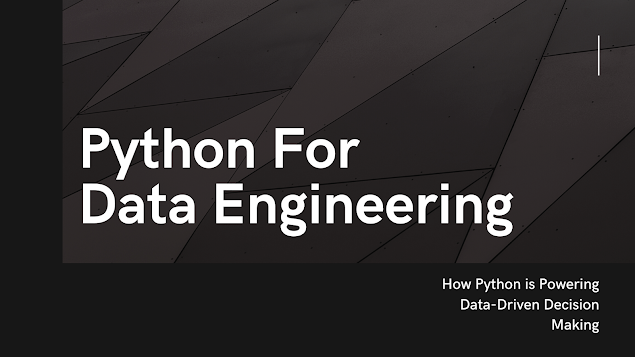A Data Engineer focuses on designing, constructing, and maintaining the systems and infrastructure that support data analysis. They may use tools such as Hadoop and Spark to process and store large amounts of data and use programming languages such as Python and Java to build and maintain data pipelines. They also work on creating efficient and scalable data architectures to ensure smooth data flow and processing. In this article, we will focus on the importance of Python in Data Engineering and how Data Engineers use Python for their day-to-day tasks.
Importance of Python in Data Engineering
Python has various tools available for handling and analyzing data, making it a suitable choice for data-related tasks. Some popular libraries and frameworks used by data engineers include,
Pandas: A library for data manipulation and analysis that provides data structures and data analysis tools similar to those in R and Excel.
Numpy: A library for numerical computation that provides a robust array and matrix data structure.
Scipy: A library for advanced mathematical computation, which offers functions for tasks such as optimization, integration, interpolation, and solving eigenvalue problems.
Desk: A parallel computing library that allows you to use familiar NumPy and Pandas operations on larger-than-memory and distributed datasets.
PySpark: A Python library for working with Apache Spark, an open-source, distributed computing system that is capable of efficiently processing large amounts of data.
Airflow: A platform that allows for the creation, scheduling, and monitoring of workflows using code, making it possible to construct and maintain intricate data pipelines using Python.
How do Data Engineers use Python?
Data engineers use Python to develop and maintain the systems and infrastructure that support data analysis; thus, it is necessary to hire Data engineer with expertise in Python. Some common ways they use Python include:
Data Extraction, Transformation, and Loading (ETL): Data engineers use Python to extract data from various sources (e.g., databases, APIs, flat files) and transform it into a suitable format for analysis. They then use Python to load the transformed data into a data warehouse or storage system.
Data Pipelines: Data engineers employ Python to create data pipelines that automate the extraction, transformation, and loading of data. These pipelines are often made using libraries such as Pandas, Numpy, and Dask, which provide potent data manipulation and analysis capabilities.
Data Quality and Validation: Data engineers use Python to write scripts that perform data quality checks and validation. These scripts can check for missing values, data consistency, and invalid data types.
Data Visualization: Data engineers use Python to create visualizations that help them understand and debug data pipelines. They can use libraries such as Matplotlib and Seaborn to create visualizations.
Monitoring and Scheduling: Data engineers use Python to build scripts that monitor the health of data pipelines and schedule jobs to run at specific times or when certain conditions are met.
Machine Learning: Some data engineers use Python to build and test machine learning models. They use libraries such as scikit-learn and TensorFlow to develop and test models and use them to make predictions or classify data.
Other Programming languages of Data Engineers' Choice
In addition to Python, data engineers also commonly use other programming languages depending on the specific tools and technologies they are working with. Some other popular programming languages data engineers use;
SQL: Data engineers often use SQL to interact with relational databases and perform data manipulation tasks. SQL is the standard language for relational databases and is widely supported by most database management systems.
Java: Java is a popular programming language for building large-scale distributed systems. Data engineers often use Java to build data pipelines and work with big data technologies such as Apache Hadoop and Apache Spark.
Scala: Like Java, Scala is a popular programming language for big data technologies such as Apache Spark. Scala is similar to Java but has additional features such as support for functional programming and a more expressive type system.
R: R is a programming language well-suited for data analysis and statistics. Data engineers may use R to perform statistical analyses and create visualizations, although it's less common than Python.
C++: C++ is a general-purpose programming language often used for low-level system programming and developing performance-critical systems. Data engineers may use C++ to implement high-performance components of data pipelines or to interface with other systems written in C++.
Conclusion
It's worth noting that the choice of programming languages depends on the specific use case, the tools and technologies used, and the preferences and expertise of the data engineer. Data engineers are often required to work with multiple programming languages and to be able to learn and use new technologies as they become available quickly. Python's simplicity and ease of use make it an excellent choice for data engineers who need to rapidly prototype and test data pipelines. Its wide range of libraries and frameworks makes it a powerful tool for building and maintaining large-scale data infrastructures.
Apart from data engineering, Python has many other applications. You can hire dedicated Python developers for the following:
Web Development
Software Development
Enterprise-level Business Applications
Game Development
Artificial Intelligence And Machine Learning
Scientific And Numeric Application Development
Language Development

Comments
Post a Comment